Woolworths Market Analysis
VerifiedAdded on 2023/03/20
|16
|3960
|40
AI Summary
This paper presents a market analysis of Woolworths, the largest retail firm in Australia. It covers the company's overview, the retail industry in Australia, market structure, determinants of demand and supply, and recent events affecting the industry.
Contribute Materials
Your contribution can guide someone’s learning journey. Share your
documents today.

WOOLWORTHS MARKET ANALYSIS 1
WOOLWORTHS MARKET ANALYSIS
Student name
Institution affiliation
Facilitator
Course
Date
WOOLWORTHS MARKET ANALYSIS
Student name
Institution affiliation
Facilitator
Course
Date
Secure Best Marks with AI Grader
Need help grading? Try our AI Grader for instant feedback on your assignments.
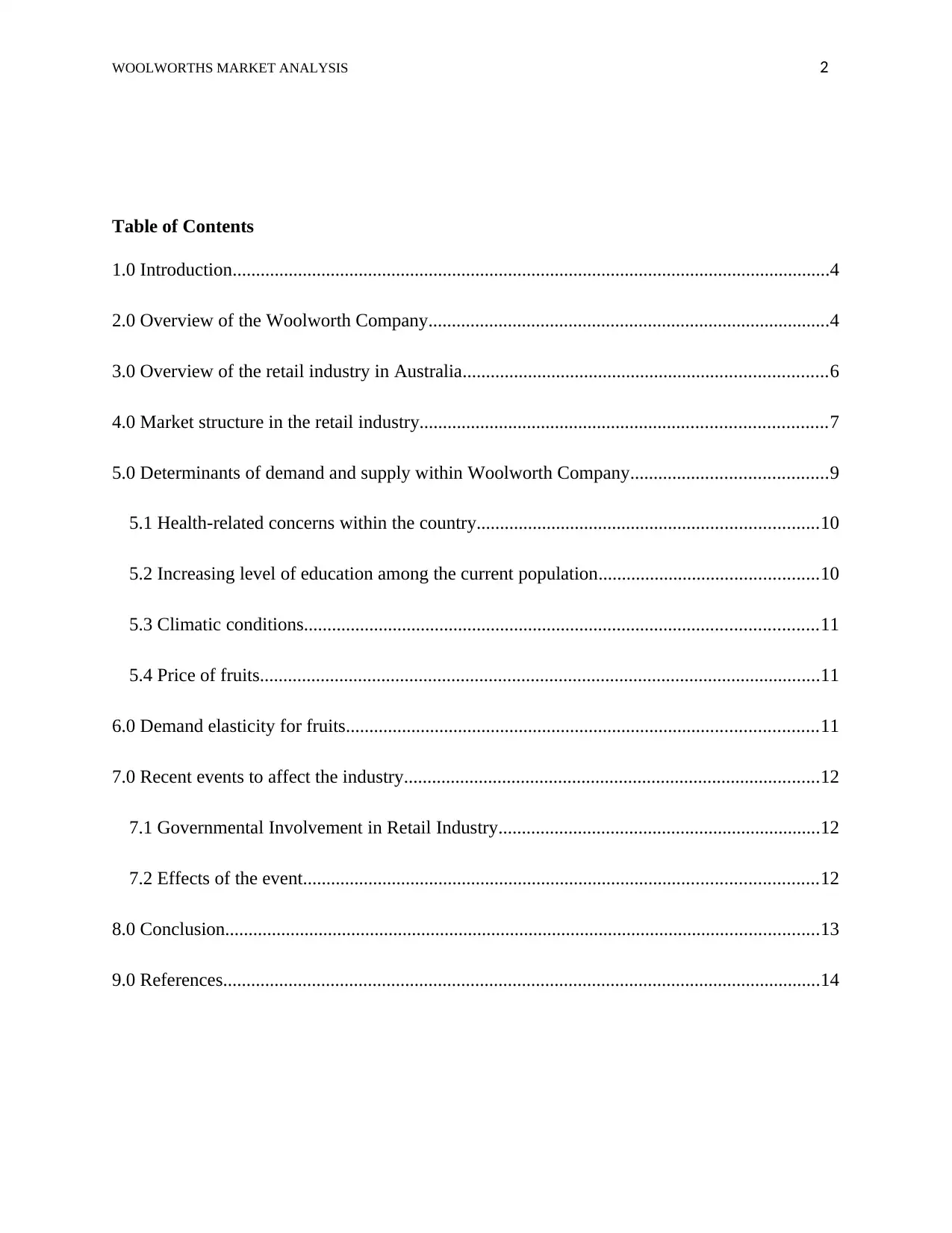
WOOLWORTHS MARKET ANALYSIS 2
Table of Contents
1.0 Introduction................................................................................................................................4
2.0 Overview of the Woolworth Company......................................................................................4
3.0 Overview of the retail industry in Australia..............................................................................6
4.0 Market structure in the retail industry.......................................................................................7
5.0 Determinants of demand and supply within Woolworth Company..........................................9
5.1 Health-related concerns within the country.........................................................................10
5.2 Increasing level of education among the current population...............................................10
5.3 Climatic conditions..............................................................................................................11
5.4 Price of fruits........................................................................................................................11
6.0 Demand elasticity for fruits.....................................................................................................11
7.0 Recent events to affect the industry.........................................................................................12
7.1 Governmental Involvement in Retail Industry.....................................................................12
7.2 Effects of the event..............................................................................................................12
8.0 Conclusion...............................................................................................................................13
9.0 References................................................................................................................................14
Table of Contents
1.0 Introduction................................................................................................................................4
2.0 Overview of the Woolworth Company......................................................................................4
3.0 Overview of the retail industry in Australia..............................................................................6
4.0 Market structure in the retail industry.......................................................................................7
5.0 Determinants of demand and supply within Woolworth Company..........................................9
5.1 Health-related concerns within the country.........................................................................10
5.2 Increasing level of education among the current population...............................................10
5.3 Climatic conditions..............................................................................................................11
5.4 Price of fruits........................................................................................................................11
6.0 Demand elasticity for fruits.....................................................................................................11
7.0 Recent events to affect the industry.........................................................................................12
7.1 Governmental Involvement in Retail Industry.....................................................................12
7.2 Effects of the event..............................................................................................................12
8.0 Conclusion...............................................................................................................................13
9.0 References................................................................................................................................14
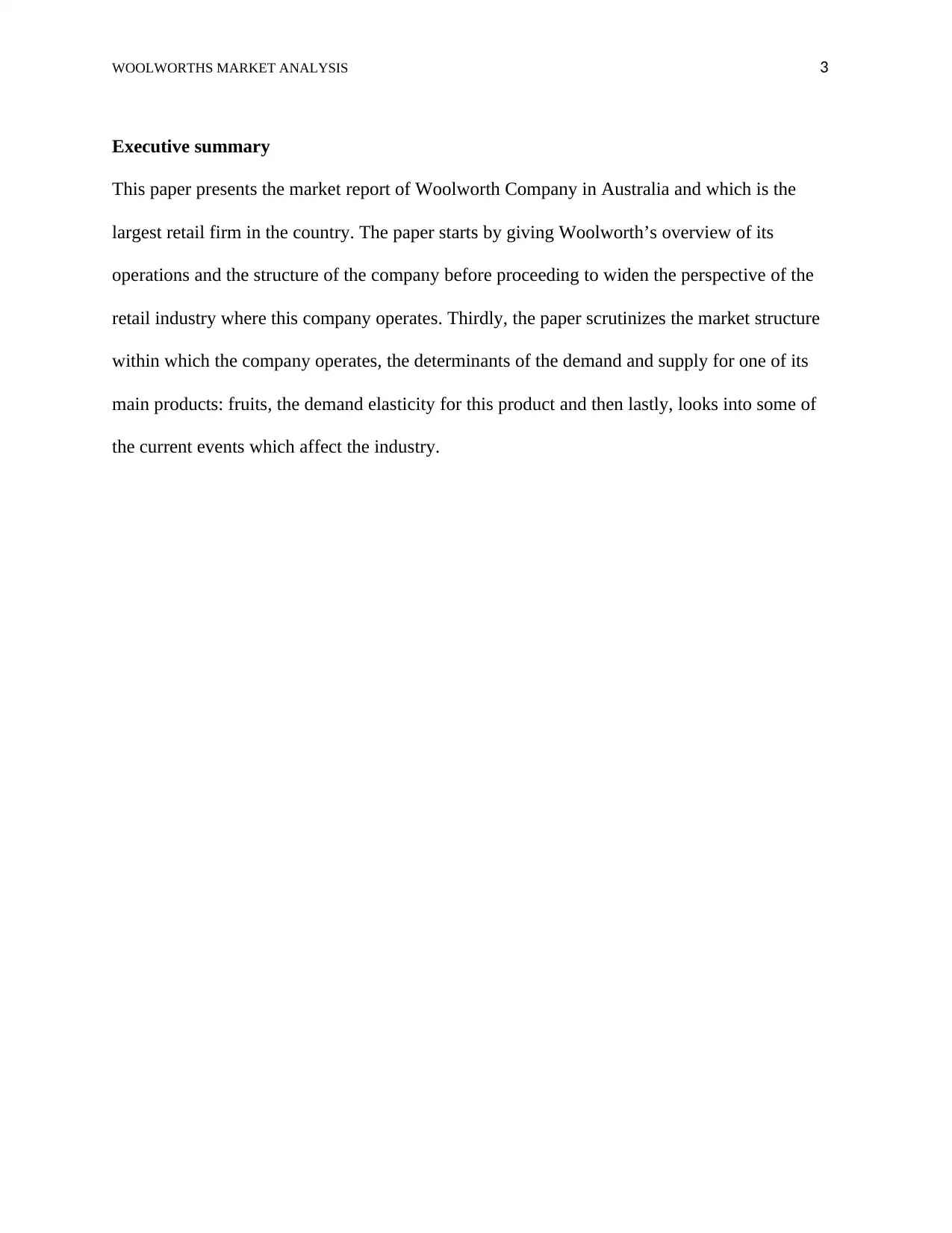
WOOLWORTHS MARKET ANALYSIS 3
Executive summary
This paper presents the market report of Woolworth Company in Australia and which is the
largest retail firm in the country. The paper starts by giving Woolworth’s overview of its
operations and the structure of the company before proceeding to widen the perspective of the
retail industry where this company operates. Thirdly, the paper scrutinizes the market structure
within which the company operates, the determinants of the demand and supply for one of its
main products: fruits, the demand elasticity for this product and then lastly, looks into some of
the current events which affect the industry.
Executive summary
This paper presents the market report of Woolworth Company in Australia and which is the
largest retail firm in the country. The paper starts by giving Woolworth’s overview of its
operations and the structure of the company before proceeding to widen the perspective of the
retail industry where this company operates. Thirdly, the paper scrutinizes the market structure
within which the company operates, the determinants of the demand and supply for one of its
main products: fruits, the demand elasticity for this product and then lastly, looks into some of
the current events which affect the industry.
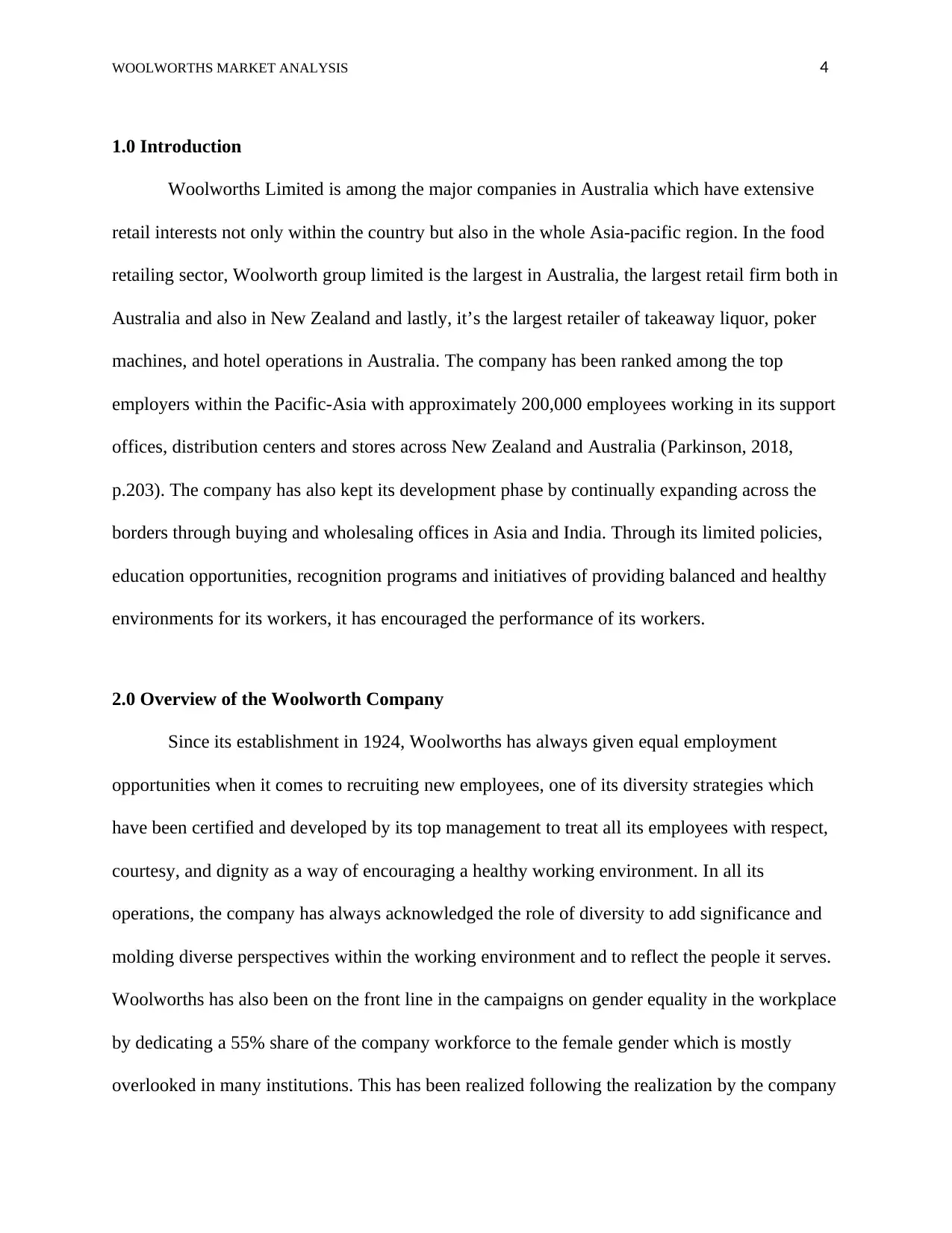
WOOLWORTHS MARKET ANALYSIS 4
1.0 Introduction
Woolworths Limited is among the major companies in Australia which have extensive
retail interests not only within the country but also in the whole Asia-pacific region. In the food
retailing sector, Woolworth group limited is the largest in Australia, the largest retail firm both in
Australia and also in New Zealand and lastly, it’s the largest retailer of takeaway liquor, poker
machines, and hotel operations in Australia. The company has been ranked among the top
employers within the Pacific-Asia with approximately 200,000 employees working in its support
offices, distribution centers and stores across New Zealand and Australia (Parkinson, 2018,
p.203). The company has also kept its development phase by continually expanding across the
borders through buying and wholesaling offices in Asia and India. Through its limited policies,
education opportunities, recognition programs and initiatives of providing balanced and healthy
environments for its workers, it has encouraged the performance of its workers.
2.0 Overview of the Woolworth Company
Since its establishment in 1924, Woolworths has always given equal employment
opportunities when it comes to recruiting new employees, one of its diversity strategies which
have been certified and developed by its top management to treat all its employees with respect,
courtesy, and dignity as a way of encouraging a healthy working environment. In all its
operations, the company has always acknowledged the role of diversity to add significance and
molding diverse perspectives within the working environment and to reflect the people it serves.
Woolworths has also been on the front line in the campaigns on gender equality in the workplace
by dedicating a 55% share of the company workforce to the female gender which is mostly
overlooked in many institutions. This has been realized following the realization by the company
1.0 Introduction
Woolworths Limited is among the major companies in Australia which have extensive
retail interests not only within the country but also in the whole Asia-pacific region. In the food
retailing sector, Woolworth group limited is the largest in Australia, the largest retail firm both in
Australia and also in New Zealand and lastly, it’s the largest retailer of takeaway liquor, poker
machines, and hotel operations in Australia. The company has been ranked among the top
employers within the Pacific-Asia with approximately 200,000 employees working in its support
offices, distribution centers and stores across New Zealand and Australia (Parkinson, 2018,
p.203). The company has also kept its development phase by continually expanding across the
borders through buying and wholesaling offices in Asia and India. Through its limited policies,
education opportunities, recognition programs and initiatives of providing balanced and healthy
environments for its workers, it has encouraged the performance of its workers.
2.0 Overview of the Woolworth Company
Since its establishment in 1924, Woolworths has always given equal employment
opportunities when it comes to recruiting new employees, one of its diversity strategies which
have been certified and developed by its top management to treat all its employees with respect,
courtesy, and dignity as a way of encouraging a healthy working environment. In all its
operations, the company has always acknowledged the role of diversity to add significance and
molding diverse perspectives within the working environment and to reflect the people it serves.
Woolworths has also been on the front line in the campaigns on gender equality in the workplace
by dedicating a 55% share of the company workforce to the female gender which is mostly
overlooked in many institutions. This has been realized following the realization by the company
Secure Best Marks with AI Grader
Need help grading? Try our AI Grader for instant feedback on your assignments.

WOOLWORTHS MARKET ANALYSIS 5
top management that male and female offer distinct perspectives on business (Parkinson, 2018,
p.203).
The company has a firm dedication in building internal ability. It considers this approach
as the main driver of its capacity to perform, change and grow. The company has been retaining
more of its employees during the past few years and that has seen it's turnover rates continue to
decrease within its main territories and states. For this company to retain its diverse employee
base, it has been offering financial as well as non-financial benefits to its employees who include
flexible work arrangements, paid maternity leaves, professional development opportunities and a
range wellness programs (Parkinson, 2018, p.203). The long term goal of this company is to be
recognized as a leader in the sustainable retailing sector and which has been realized by
integrating and incorporating sustainability and responsibility programs in its day to day business
activities.
The company has been supporting competition in the retail sector and which has helped
consumers to enjoy low prices for the goods supplied in this sector as well as forcing the retailers
to supply quality products and services (Parkinson, 2018, p.203). Through its support for a
competitive environment, the food retail sector within the Pacific-Asia has become highly
competitive and with many retailers entering into the markets and growth being realized in many
independent and specialist retailers. Through such awareness, Woolworths limited has been able
to dominate the food retail business.
The continued growth and success of Woolworths limited have been highly attributed to
its concentration in building its in-house capacity. The company has been retaining its talented
top management that male and female offer distinct perspectives on business (Parkinson, 2018,
p.203).
The company has a firm dedication in building internal ability. It considers this approach
as the main driver of its capacity to perform, change and grow. The company has been retaining
more of its employees during the past few years and that has seen it's turnover rates continue to
decrease within its main territories and states. For this company to retain its diverse employee
base, it has been offering financial as well as non-financial benefits to its employees who include
flexible work arrangements, paid maternity leaves, professional development opportunities and a
range wellness programs (Parkinson, 2018, p.203). The long term goal of this company is to be
recognized as a leader in the sustainable retailing sector and which has been realized by
integrating and incorporating sustainability and responsibility programs in its day to day business
activities.
The company has been supporting competition in the retail sector and which has helped
consumers to enjoy low prices for the goods supplied in this sector as well as forcing the retailers
to supply quality products and services (Parkinson, 2018, p.203). Through its support for a
competitive environment, the food retail sector within the Pacific-Asia has become highly
competitive and with many retailers entering into the markets and growth being realized in many
independent and specialist retailers. Through such awareness, Woolworths limited has been able
to dominate the food retail business.
The continued growth and success of Woolworths limited have been highly attributed to
its concentration in building its in-house capacity. The company has been retaining its talented
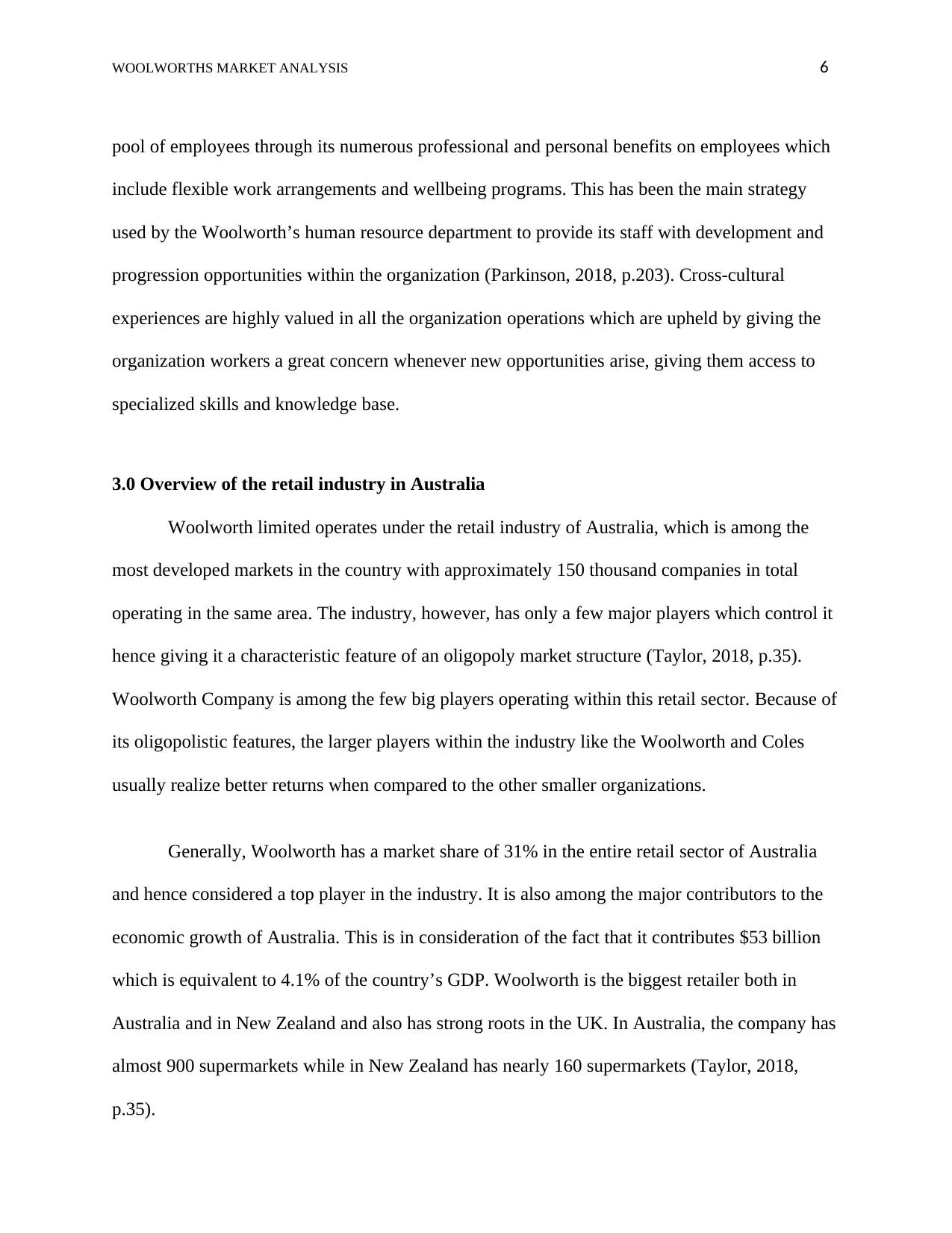
WOOLWORTHS MARKET ANALYSIS 6
pool of employees through its numerous professional and personal benefits on employees which
include flexible work arrangements and wellbeing programs. This has been the main strategy
used by the Woolworth’s human resource department to provide its staff with development and
progression opportunities within the organization (Parkinson, 2018, p.203). Cross-cultural
experiences are highly valued in all the organization operations which are upheld by giving the
organization workers a great concern whenever new opportunities arise, giving them access to
specialized skills and knowledge base.
3.0 Overview of the retail industry in Australia
Woolworth limited operates under the retail industry of Australia, which is among the
most developed markets in the country with approximately 150 thousand companies in total
operating in the same area. The industry, however, has only a few major players which control it
hence giving it a characteristic feature of an oligopoly market structure (Taylor, 2018, p.35).
Woolworth Company is among the few big players operating within this retail sector. Because of
its oligopolistic features, the larger players within the industry like the Woolworth and Coles
usually realize better returns when compared to the other smaller organizations.
Generally, Woolworth has a market share of 31% in the entire retail sector of Australia
and hence considered a top player in the industry. It is also among the major contributors to the
economic growth of Australia. This is in consideration of the fact that it contributes $53 billion
which is equivalent to 4.1% of the country’s GDP. Woolworth is the biggest retailer both in
Australia and in New Zealand and also has strong roots in the UK. In Australia, the company has
almost 900 supermarkets while in New Zealand has nearly 160 supermarkets (Taylor, 2018,
p.35).
pool of employees through its numerous professional and personal benefits on employees which
include flexible work arrangements and wellbeing programs. This has been the main strategy
used by the Woolworth’s human resource department to provide its staff with development and
progression opportunities within the organization (Parkinson, 2018, p.203). Cross-cultural
experiences are highly valued in all the organization operations which are upheld by giving the
organization workers a great concern whenever new opportunities arise, giving them access to
specialized skills and knowledge base.
3.0 Overview of the retail industry in Australia
Woolworth limited operates under the retail industry of Australia, which is among the
most developed markets in the country with approximately 150 thousand companies in total
operating in the same area. The industry, however, has only a few major players which control it
hence giving it a characteristic feature of an oligopoly market structure (Taylor, 2018, p.35).
Woolworth Company is among the few big players operating within this retail sector. Because of
its oligopolistic features, the larger players within the industry like the Woolworth and Coles
usually realize better returns when compared to the other smaller organizations.
Generally, Woolworth has a market share of 31% in the entire retail sector of Australia
and hence considered a top player in the industry. It is also among the major contributors to the
economic growth of Australia. This is in consideration of the fact that it contributes $53 billion
which is equivalent to 4.1% of the country’s GDP. Woolworth is the biggest retailer both in
Australia and in New Zealand and also has strong roots in the UK. In Australia, the company has
almost 900 supermarkets while in New Zealand has nearly 160 supermarkets (Taylor, 2018,
p.35).

WOOLWORTHS MARKET ANALYSIS 7
Since its establishment in 1924, Woolworth Company has highly invested in its growth
strategies as well as innovative programs in order to increase its market share within the industry.
For instance, Woolworth Company was the first company in the world to come up with the
technology of printing customer receipts through cash registers. Also, through its series of
acquisitions, it has managed to grow very fast and entered the foreign markets after conquering
the Australian one. Currently, the company has gotten a strong competitor called Coles Ltd but
because of the intensive competition, it has continued to be very hard and almost impossible for
new firms to enter the market (Taylor, 2018, p.35).
Coles Ltd has entered into stiff competition with Woolworth Company with serious
intentions to elevate its sales growth annually. With such a close competition, the industry has
been seriously impacted in regard to the ability of the smaller firms entering the market (Taylor,
2018, p.35). In addition, the oligopolistic nature of this market has created some serious barriers
for veteran players to increase market shares. The two companies have an immense amount of
resources which enables them to acquire high-quality staff.
4.0 Market structure in the retail industry
From the above scrutiny, it’s beyond any reasonable doubt that the Australian retail
sector operates as an oligopoly market structure (Ara and Ghosh, 2017, p.25). This is in
consideration of the fact that firms like Woolworth and Coles have a market share of
approximately 60%. According to the current statistics, the industry has a total revenue of more
than $90 billion out of which the two giants in the industry have the greatest share (Jie and
Since its establishment in 1924, Woolworth Company has highly invested in its growth
strategies as well as innovative programs in order to increase its market share within the industry.
For instance, Woolworth Company was the first company in the world to come up with the
technology of printing customer receipts through cash registers. Also, through its series of
acquisitions, it has managed to grow very fast and entered the foreign markets after conquering
the Australian one. Currently, the company has gotten a strong competitor called Coles Ltd but
because of the intensive competition, it has continued to be very hard and almost impossible for
new firms to enter the market (Taylor, 2018, p.35).
Coles Ltd has entered into stiff competition with Woolworth Company with serious
intentions to elevate its sales growth annually. With such a close competition, the industry has
been seriously impacted in regard to the ability of the smaller firms entering the market (Taylor,
2018, p.35). In addition, the oligopolistic nature of this market has created some serious barriers
for veteran players to increase market shares. The two companies have an immense amount of
resources which enables them to acquire high-quality staff.
4.0 Market structure in the retail industry
From the above scrutiny, it’s beyond any reasonable doubt that the Australian retail
sector operates as an oligopoly market structure (Ara and Ghosh, 2017, p.25). This is in
consideration of the fact that firms like Woolworth and Coles have a market share of
approximately 60%. According to the current statistics, the industry has a total revenue of more
than $90 billion out of which the two giants in the industry have the greatest share (Jie and
Paraphrase This Document
Need a fresh take? Get an instant paraphrase of this document with our AI Paraphraser

WOOLWORTHS MARKET ANALYSIS 8
Gengatharen, 2018, p.65). Woolworth’s alone having a share of $51.9 billion while Coles having
$30 billion. From an economic point of view, such a high-profit margin is associated with the
dominance of firms in an industry. When the two firms are considered together, they have a
market share of 108% making the sector to look like a pure duopoly (Head and Spencer, 2017,
p.1414). This extreme dominance in the sector has bestowed a certain degree of power to
Woolworth and which has made it rule over the Australian food market.
Following the rise of Cole’s to join Woolworth’s in the 1960s; entry into Australia’s food
retail industry has become very hard for small firms like Shoey’s. After their frequent trials to
compete with the two giants: Woolworth’s and Coles, they eventually shut down after some few
years of operation because they were unable to match with the scale and operations of the two
giants, ever since the industry has not registered any new entry into the market because the
barriers have continued to diversify (Saeedi et al, 2017, p.150). This is despite the fact that
globalization has revolutionized most sectors within the country and opened them in the global
economy.
Food retail market sector in Australia has been highly profitable and has been
experiencing a steady growth rate over the past few years. The grocery sector, for instance, has
registered a growth rate of almost70% between 2012 and 2018; which has been mainly attributed
to the exemplary performance of both Woolworth and Cole. Woolworth revenue has undergone a
constant increase from $ 54,200 in 2011 up to $85,000 currently (Duan and Kwesi, 2018)This
sharp increase in Woolworth revenues has been achieved through the adoption of projects such
as ‘Refresh Project’ and ‘Every day Low prices’ which saw the company penetrate the market
with ease. In addition to the penetration aspect, these two projects have led to an effective and
Gengatharen, 2018, p.65). Woolworth’s alone having a share of $51.9 billion while Coles having
$30 billion. From an economic point of view, such a high-profit margin is associated with the
dominance of firms in an industry. When the two firms are considered together, they have a
market share of 108% making the sector to look like a pure duopoly (Head and Spencer, 2017,
p.1414). This extreme dominance in the sector has bestowed a certain degree of power to
Woolworth and which has made it rule over the Australian food market.
Following the rise of Cole’s to join Woolworth’s in the 1960s; entry into Australia’s food
retail industry has become very hard for small firms like Shoey’s. After their frequent trials to
compete with the two giants: Woolworth’s and Coles, they eventually shut down after some few
years of operation because they were unable to match with the scale and operations of the two
giants, ever since the industry has not registered any new entry into the market because the
barriers have continued to diversify (Saeedi et al, 2017, p.150). This is despite the fact that
globalization has revolutionized most sectors within the country and opened them in the global
economy.
Food retail market sector in Australia has been highly profitable and has been
experiencing a steady growth rate over the past few years. The grocery sector, for instance, has
registered a growth rate of almost70% between 2012 and 2018; which has been mainly attributed
to the exemplary performance of both Woolworth and Cole. Woolworth revenue has undergone a
constant increase from $ 54,200 in 2011 up to $85,000 currently (Duan and Kwesi, 2018)This
sharp increase in Woolworth revenues has been achieved through the adoption of projects such
as ‘Refresh Project’ and ‘Every day Low prices’ which saw the company penetrate the market
with ease. In addition to the penetration aspect, these two projects have led to an effective and
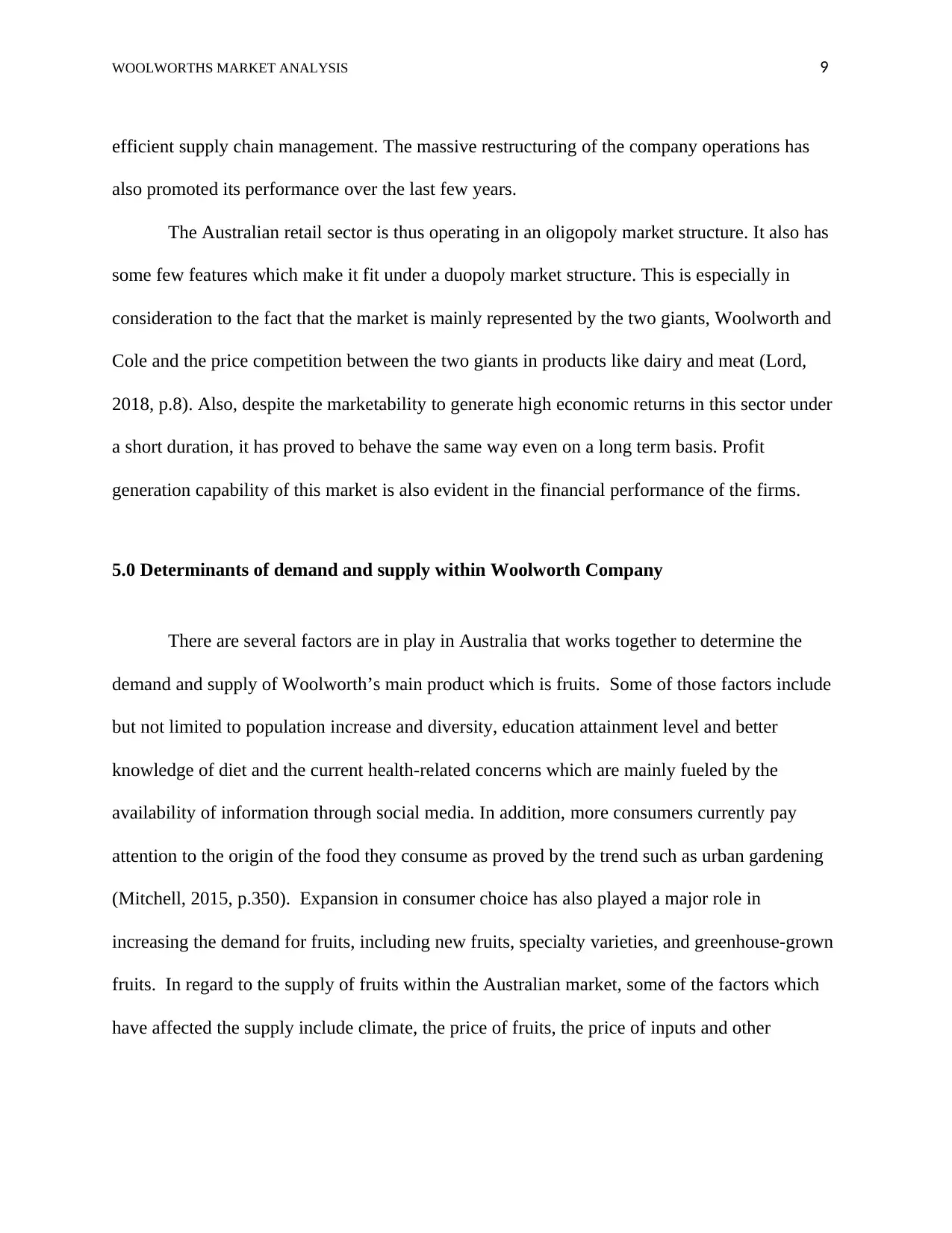
WOOLWORTHS MARKET ANALYSIS 9
efficient supply chain management. The massive restructuring of the company operations has
also promoted its performance over the last few years.
The Australian retail sector is thus operating in an oligopoly market structure. It also has
some few features which make it fit under a duopoly market structure. This is especially in
consideration to the fact that the market is mainly represented by the two giants, Woolworth and
Cole and the price competition between the two giants in products like dairy and meat (Lord,
2018, p.8). Also, despite the marketability to generate high economic returns in this sector under
a short duration, it has proved to behave the same way even on a long term basis. Profit
generation capability of this market is also evident in the financial performance of the firms.
5.0 Determinants of demand and supply within Woolworth Company
There are several factors are in play in Australia that works together to determine the
demand and supply of Woolworth’s main product which is fruits. Some of those factors include
but not limited to population increase and diversity, education attainment level and better
knowledge of diet and the current health-related concerns which are mainly fueled by the
availability of information through social media. In addition, more consumers currently pay
attention to the origin of the food they consume as proved by the trend such as urban gardening
(Mitchell, 2015, p.350). Expansion in consumer choice has also played a major role in
increasing the demand for fruits, including new fruits, specialty varieties, and greenhouse-grown
fruits. In regard to the supply of fruits within the Australian market, some of the factors which
have affected the supply include climate, the price of fruits, the price of inputs and other
efficient supply chain management. The massive restructuring of the company operations has
also promoted its performance over the last few years.
The Australian retail sector is thus operating in an oligopoly market structure. It also has
some few features which make it fit under a duopoly market structure. This is especially in
consideration to the fact that the market is mainly represented by the two giants, Woolworth and
Cole and the price competition between the two giants in products like dairy and meat (Lord,
2018, p.8). Also, despite the marketability to generate high economic returns in this sector under
a short duration, it has proved to behave the same way even on a long term basis. Profit
generation capability of this market is also evident in the financial performance of the firms.
5.0 Determinants of demand and supply within Woolworth Company
There are several factors are in play in Australia that works together to determine the
demand and supply of Woolworth’s main product which is fruits. Some of those factors include
but not limited to population increase and diversity, education attainment level and better
knowledge of diet and the current health-related concerns which are mainly fueled by the
availability of information through social media. In addition, more consumers currently pay
attention to the origin of the food they consume as proved by the trend such as urban gardening
(Mitchell, 2015, p.350). Expansion in consumer choice has also played a major role in
increasing the demand for fruits, including new fruits, specialty varieties, and greenhouse-grown
fruits. In regard to the supply of fruits within the Australian market, some of the factors which
have affected the supply include climate, the price of fruits, the price of inputs and other
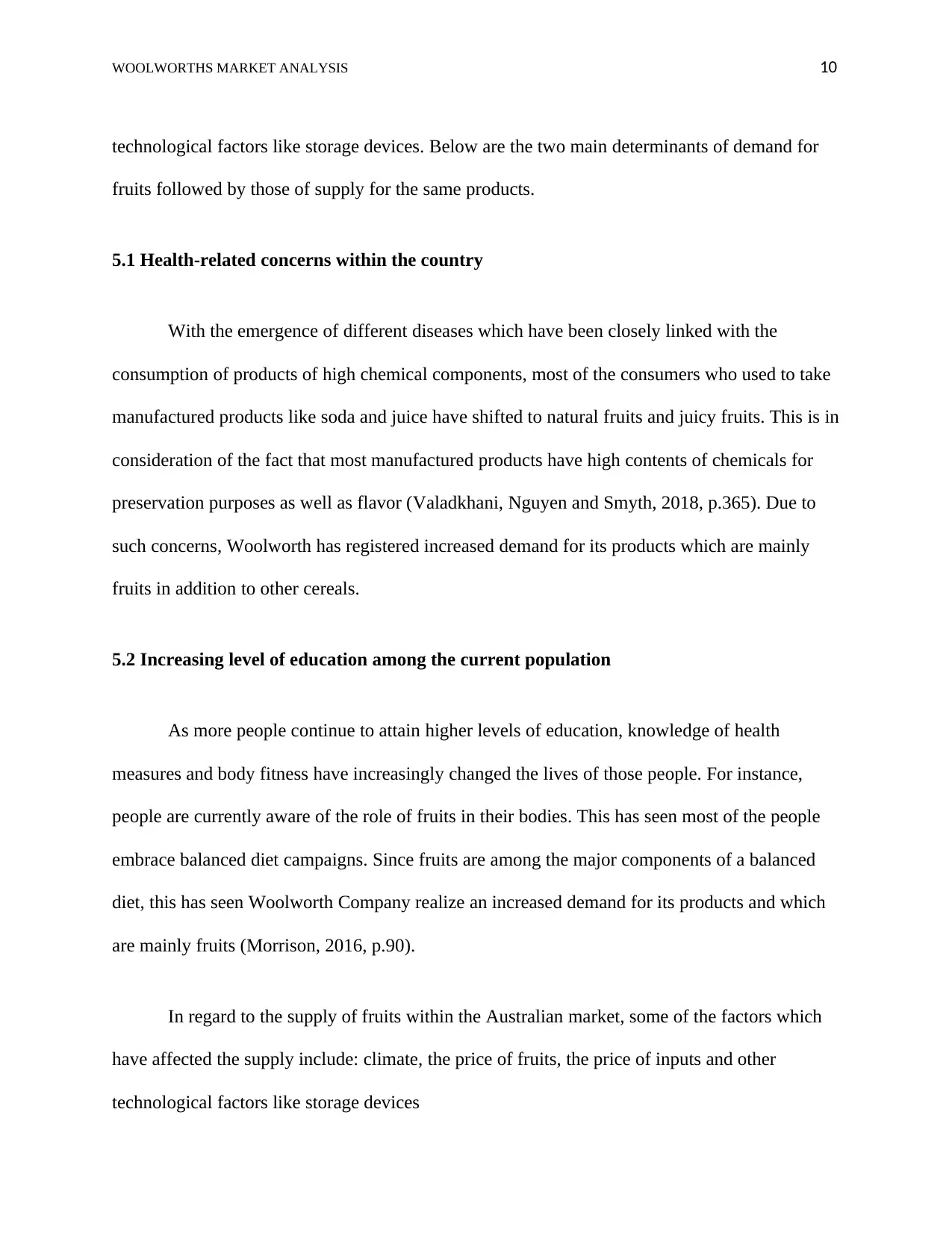
WOOLWORTHS MARKET ANALYSIS 10
technological factors like storage devices. Below are the two main determinants of demand for
fruits followed by those of supply for the same products.
5.1 Health-related concerns within the country
With the emergence of different diseases which have been closely linked with the
consumption of products of high chemical components, most of the consumers who used to take
manufactured products like soda and juice have shifted to natural fruits and juicy fruits. This is in
consideration of the fact that most manufactured products have high contents of chemicals for
preservation purposes as well as flavor (Valadkhani, Nguyen and Smyth, 2018, p.365). Due to
such concerns, Woolworth has registered increased demand for its products which are mainly
fruits in addition to other cereals.
5.2 Increasing level of education among the current population
As more people continue to attain higher levels of education, knowledge of health
measures and body fitness have increasingly changed the lives of those people. For instance,
people are currently aware of the role of fruits in their bodies. This has seen most of the people
embrace balanced diet campaigns. Since fruits are among the major components of a balanced
diet, this has seen Woolworth Company realize an increased demand for its products and which
are mainly fruits (Morrison, 2016, p.90).
In regard to the supply of fruits within the Australian market, some of the factors which
have affected the supply include: climate, the price of fruits, the price of inputs and other
technological factors like storage devices
technological factors like storage devices. Below are the two main determinants of demand for
fruits followed by those of supply for the same products.
5.1 Health-related concerns within the country
With the emergence of different diseases which have been closely linked with the
consumption of products of high chemical components, most of the consumers who used to take
manufactured products like soda and juice have shifted to natural fruits and juicy fruits. This is in
consideration of the fact that most manufactured products have high contents of chemicals for
preservation purposes as well as flavor (Valadkhani, Nguyen and Smyth, 2018, p.365). Due to
such concerns, Woolworth has registered increased demand for its products which are mainly
fruits in addition to other cereals.
5.2 Increasing level of education among the current population
As more people continue to attain higher levels of education, knowledge of health
measures and body fitness have increasingly changed the lives of those people. For instance,
people are currently aware of the role of fruits in their bodies. This has seen most of the people
embrace balanced diet campaigns. Since fruits are among the major components of a balanced
diet, this has seen Woolworth Company realize an increased demand for its products and which
are mainly fruits (Morrison, 2016, p.90).
In regard to the supply of fruits within the Australian market, some of the factors which
have affected the supply include: climate, the price of fruits, the price of inputs and other
technological factors like storage devices
Secure Best Marks with AI Grader
Need help grading? Try our AI Grader for instant feedback on your assignments.
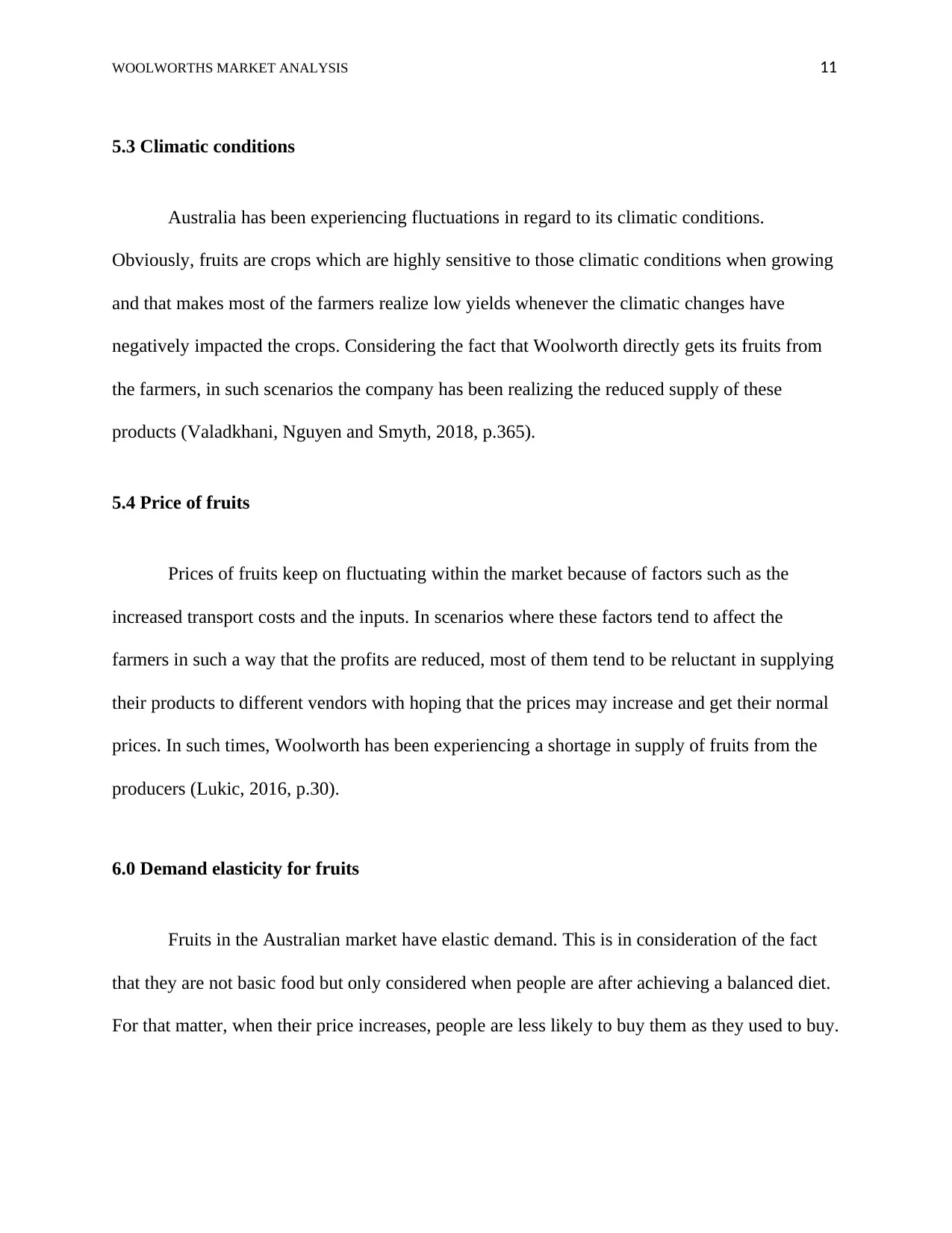
WOOLWORTHS MARKET ANALYSIS 11
5.3 Climatic conditions
Australia has been experiencing fluctuations in regard to its climatic conditions.
Obviously, fruits are crops which are highly sensitive to those climatic conditions when growing
and that makes most of the farmers realize low yields whenever the climatic changes have
negatively impacted the crops. Considering the fact that Woolworth directly gets its fruits from
the farmers, in such scenarios the company has been realizing the reduced supply of these
products (Valadkhani, Nguyen and Smyth, 2018, p.365).
5.4 Price of fruits
Prices of fruits keep on fluctuating within the market because of factors such as the
increased transport costs and the inputs. In scenarios where these factors tend to affect the
farmers in such a way that the profits are reduced, most of them tend to be reluctant in supplying
their products to different vendors with hoping that the prices may increase and get their normal
prices. In such times, Woolworth has been experiencing a shortage in supply of fruits from the
producers (Lukic, 2016, p.30).
6.0 Demand elasticity for fruits
Fruits in the Australian market have elastic demand. This is in consideration of the fact
that they are not basic food but only considered when people are after achieving a balanced diet.
For that matter, when their price increases, people are less likely to buy them as they used to buy.
5.3 Climatic conditions
Australia has been experiencing fluctuations in regard to its climatic conditions.
Obviously, fruits are crops which are highly sensitive to those climatic conditions when growing
and that makes most of the farmers realize low yields whenever the climatic changes have
negatively impacted the crops. Considering the fact that Woolworth directly gets its fruits from
the farmers, in such scenarios the company has been realizing the reduced supply of these
products (Valadkhani, Nguyen and Smyth, 2018, p.365).
5.4 Price of fruits
Prices of fruits keep on fluctuating within the market because of factors such as the
increased transport costs and the inputs. In scenarios where these factors tend to affect the
farmers in such a way that the profits are reduced, most of them tend to be reluctant in supplying
their products to different vendors with hoping that the prices may increase and get their normal
prices. In such times, Woolworth has been experiencing a shortage in supply of fruits from the
producers (Lukic, 2016, p.30).
6.0 Demand elasticity for fruits
Fruits in the Australian market have elastic demand. This is in consideration of the fact
that they are not basic food but only considered when people are after achieving a balanced diet.
For that matter, when their price increases, people are less likely to buy them as they used to buy.
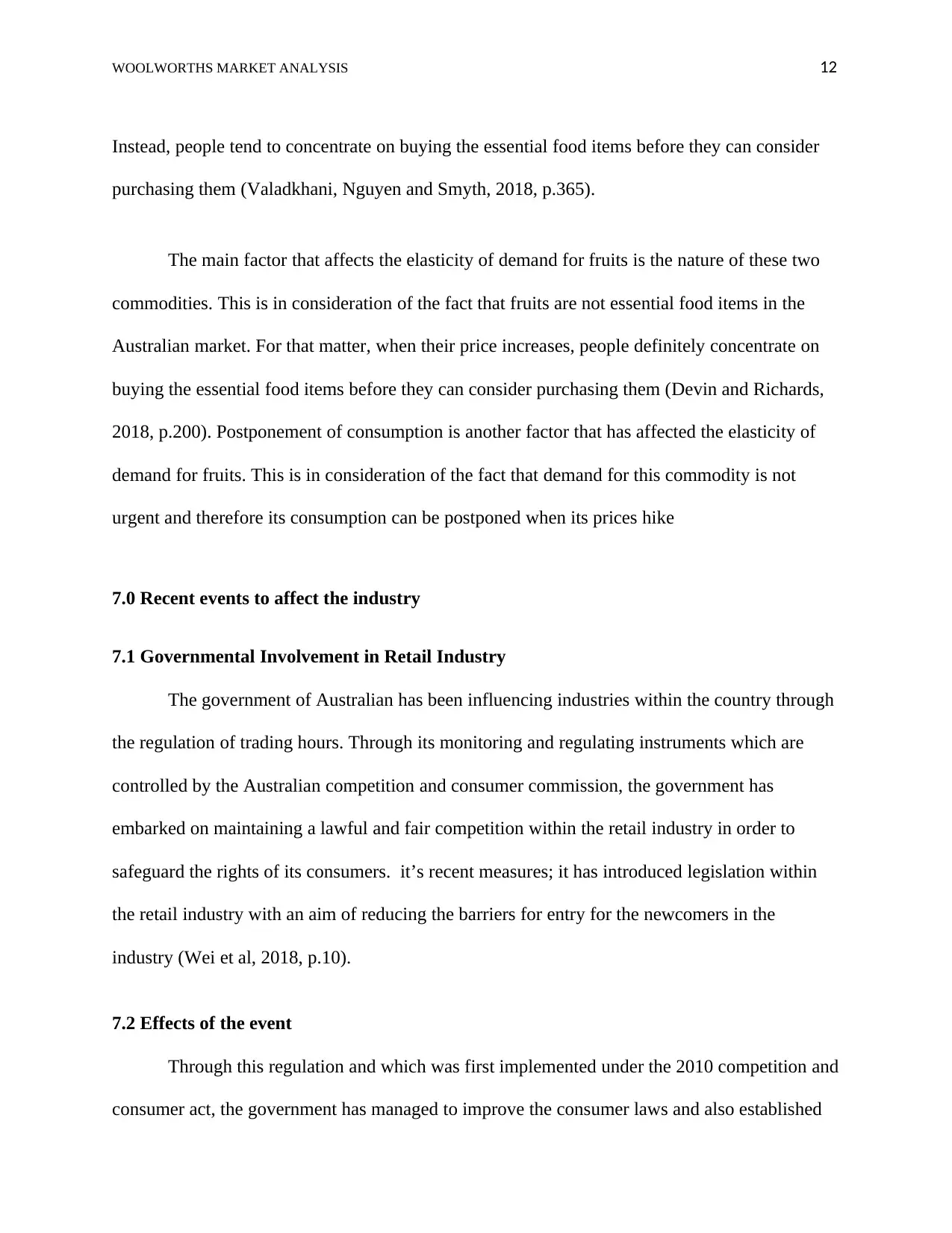
WOOLWORTHS MARKET ANALYSIS 12
Instead, people tend to concentrate on buying the essential food items before they can consider
purchasing them (Valadkhani, Nguyen and Smyth, 2018, p.365).
The main factor that affects the elasticity of demand for fruits is the nature of these two
commodities. This is in consideration of the fact that fruits are not essential food items in the
Australian market. For that matter, when their price increases, people definitely concentrate on
buying the essential food items before they can consider purchasing them (Devin and Richards,
2018, p.200). Postponement of consumption is another factor that has affected the elasticity of
demand for fruits. This is in consideration of the fact that demand for this commodity is not
urgent and therefore its consumption can be postponed when its prices hike
7.0 Recent events to affect the industry
7.1 Governmental Involvement in Retail Industry
The government of Australian has been influencing industries within the country through
the regulation of trading hours. Through its monitoring and regulating instruments which are
controlled by the Australian competition and consumer commission, the government has
embarked on maintaining a lawful and fair competition within the retail industry in order to
safeguard the rights of its consumers. it’s recent measures; it has introduced legislation within
the retail industry with an aim of reducing the barriers for entry for the newcomers in the
industry (Wei et al, 2018, p.10).
7.2 Effects of the event
Through this regulation and which was first implemented under the 2010 competition and
consumer act, the government has managed to improve the consumer laws and also established
Instead, people tend to concentrate on buying the essential food items before they can consider
purchasing them (Valadkhani, Nguyen and Smyth, 2018, p.365).
The main factor that affects the elasticity of demand for fruits is the nature of these two
commodities. This is in consideration of the fact that fruits are not essential food items in the
Australian market. For that matter, when their price increases, people definitely concentrate on
buying the essential food items before they can consider purchasing them (Devin and Richards,
2018, p.200). Postponement of consumption is another factor that has affected the elasticity of
demand for fruits. This is in consideration of the fact that demand for this commodity is not
urgent and therefore its consumption can be postponed when its prices hike
7.0 Recent events to affect the industry
7.1 Governmental Involvement in Retail Industry
The government of Australian has been influencing industries within the country through
the regulation of trading hours. Through its monitoring and regulating instruments which are
controlled by the Australian competition and consumer commission, the government has
embarked on maintaining a lawful and fair competition within the retail industry in order to
safeguard the rights of its consumers. it’s recent measures; it has introduced legislation within
the retail industry with an aim of reducing the barriers for entry for the newcomers in the
industry (Wei et al, 2018, p.10).
7.2 Effects of the event
Through this regulation and which was first implemented under the 2010 competition and
consumer act, the government has managed to improve the consumer laws and also established
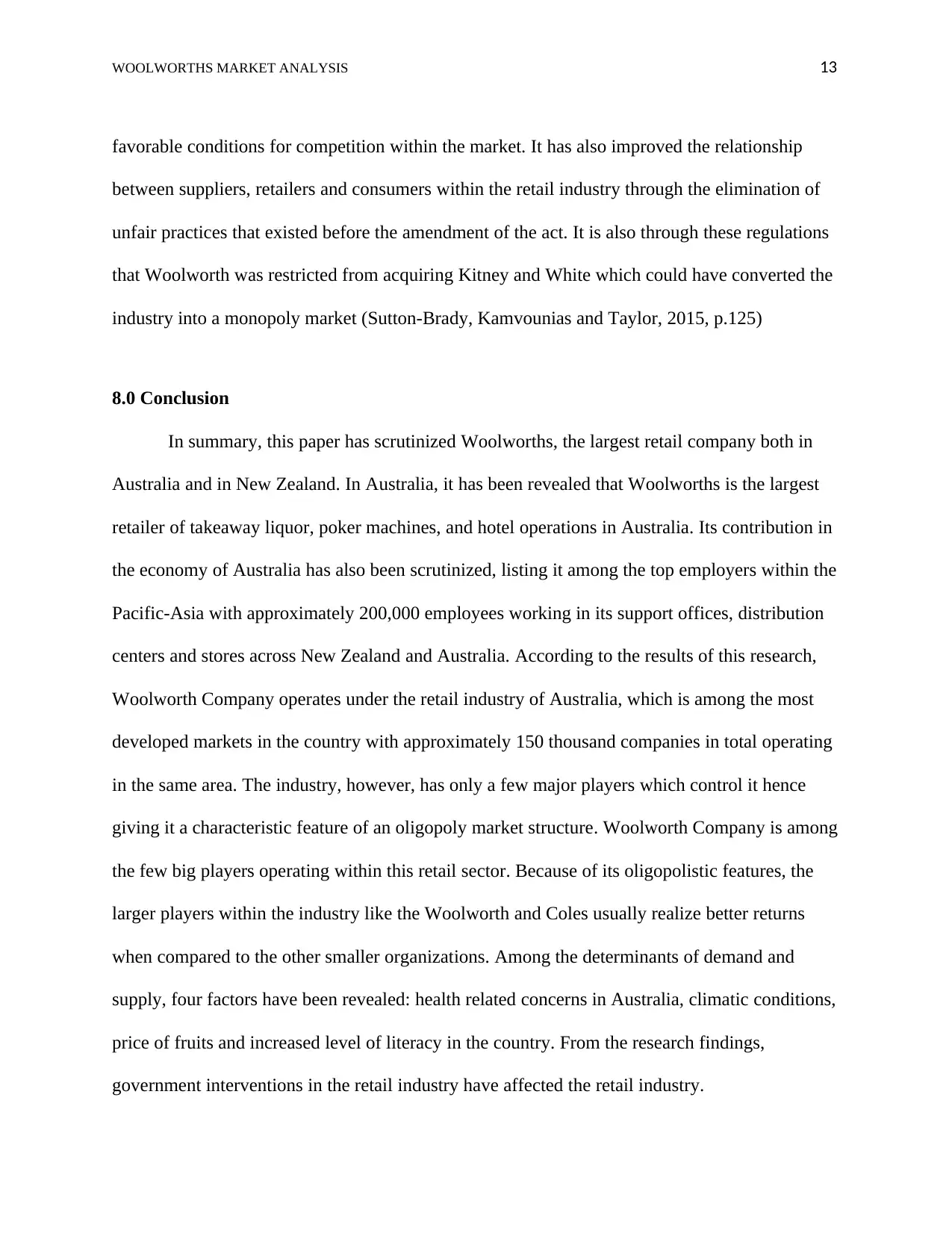
WOOLWORTHS MARKET ANALYSIS 13
favorable conditions for competition within the market. It has also improved the relationship
between suppliers, retailers and consumers within the retail industry through the elimination of
unfair practices that existed before the amendment of the act. It is also through these regulations
that Woolworth was restricted from acquiring Kitney and White which could have converted the
industry into a monopoly market (Sutton-Brady, Kamvounias and Taylor, 2015, p.125)
8.0 Conclusion
In summary, this paper has scrutinized Woolworths, the largest retail company both in
Australia and in New Zealand. In Australia, it has been revealed that Woolworths is the largest
retailer of takeaway liquor, poker machines, and hotel operations in Australia. Its contribution in
the economy of Australia has also been scrutinized, listing it among the top employers within the
Pacific-Asia with approximately 200,000 employees working in its support offices, distribution
centers and stores across New Zealand and Australia. According to the results of this research,
Woolworth Company operates under the retail industry of Australia, which is among the most
developed markets in the country with approximately 150 thousand companies in total operating
in the same area. The industry, however, has only a few major players which control it hence
giving it a characteristic feature of an oligopoly market structure. Woolworth Company is among
the few big players operating within this retail sector. Because of its oligopolistic features, the
larger players within the industry like the Woolworth and Coles usually realize better returns
when compared to the other smaller organizations. Among the determinants of demand and
supply, four factors have been revealed: health related concerns in Australia, climatic conditions,
price of fruits and increased level of literacy in the country. From the research findings,
government interventions in the retail industry have affected the retail industry.
favorable conditions for competition within the market. It has also improved the relationship
between suppliers, retailers and consumers within the retail industry through the elimination of
unfair practices that existed before the amendment of the act. It is also through these regulations
that Woolworth was restricted from acquiring Kitney and White which could have converted the
industry into a monopoly market (Sutton-Brady, Kamvounias and Taylor, 2015, p.125)
8.0 Conclusion
In summary, this paper has scrutinized Woolworths, the largest retail company both in
Australia and in New Zealand. In Australia, it has been revealed that Woolworths is the largest
retailer of takeaway liquor, poker machines, and hotel operations in Australia. Its contribution in
the economy of Australia has also been scrutinized, listing it among the top employers within the
Pacific-Asia with approximately 200,000 employees working in its support offices, distribution
centers and stores across New Zealand and Australia. According to the results of this research,
Woolworth Company operates under the retail industry of Australia, which is among the most
developed markets in the country with approximately 150 thousand companies in total operating
in the same area. The industry, however, has only a few major players which control it hence
giving it a characteristic feature of an oligopoly market structure. Woolworth Company is among
the few big players operating within this retail sector. Because of its oligopolistic features, the
larger players within the industry like the Woolworth and Coles usually realize better returns
when compared to the other smaller organizations. Among the determinants of demand and
supply, four factors have been revealed: health related concerns in Australia, climatic conditions,
price of fruits and increased level of literacy in the country. From the research findings,
government interventions in the retail industry have affected the retail industry.
Paraphrase This Document
Need a fresh take? Get an instant paraphrase of this document with our AI Paraphraser

WOOLWORTHS MARKET ANALYSIS 14
9.0 References
Ara, T. and Ghosh, A., 2017. Tariffs, Vertical Oligopoly and Market Structure. RIETI
Discussion Paper Series 17-E-025.
Devin, B. and Richards, C., 2018. Food waste, power, and corporate social responsibility in the
Australian food supply chain. Journal of Business Ethics, 150(1), pp.199-210.
Duan, J. and Kwesi, A.E., 2018. The Market Structure of the Ghanaian Insurance
Market. DEStech Transactions on Economics, Business and Management, (icems).
Fairbrother, P., Rafferty, M., Douglas, N. and Wang, L., 2018. Retiring Hurt? The Long-term
Costs of Structural Conflicts of Duty and Interest in the Superannuation Industry.
Head, K. and Spencer, B.J., 2017. Oligopoly in international trade: Rise, fall and
resurgence. Canadian Journal of Economics/Revue canadienne d'économique, 50(5), pp.1414-
1444.
Jie, F. and Gengatharen, D., 2018. Australian food retail supply chain analysis. Business Process
Management Journal.
Lord, J., 2018. Downtown Bakersfield: A time capsule of the 1950s. Spirit of Progress, 19(4),
p.8.
Lukic, R., 2016. Energy efficiency in the food retail. Business Excellence and Management, 6(1),
pp.16-35.
9.0 References
Ara, T. and Ghosh, A., 2017. Tariffs, Vertical Oligopoly and Market Structure. RIETI
Discussion Paper Series 17-E-025.
Devin, B. and Richards, C., 2018. Food waste, power, and corporate social responsibility in the
Australian food supply chain. Journal of Business Ethics, 150(1), pp.199-210.
Duan, J. and Kwesi, A.E., 2018. The Market Structure of the Ghanaian Insurance
Market. DEStech Transactions on Economics, Business and Management, (icems).
Fairbrother, P., Rafferty, M., Douglas, N. and Wang, L., 2018. Retiring Hurt? The Long-term
Costs of Structural Conflicts of Duty and Interest in the Superannuation Industry.
Head, K. and Spencer, B.J., 2017. Oligopoly in international trade: Rise, fall and
resurgence. Canadian Journal of Economics/Revue canadienne d'économique, 50(5), pp.1414-
1444.
Jie, F. and Gengatharen, D., 2018. Australian food retail supply chain analysis. Business Process
Management Journal.
Lord, J., 2018. Downtown Bakersfield: A time capsule of the 1950s. Spirit of Progress, 19(4),
p.8.
Lukic, R., 2016. Energy efficiency in the food retail. Business Excellence and Management, 6(1),
pp.16-35.
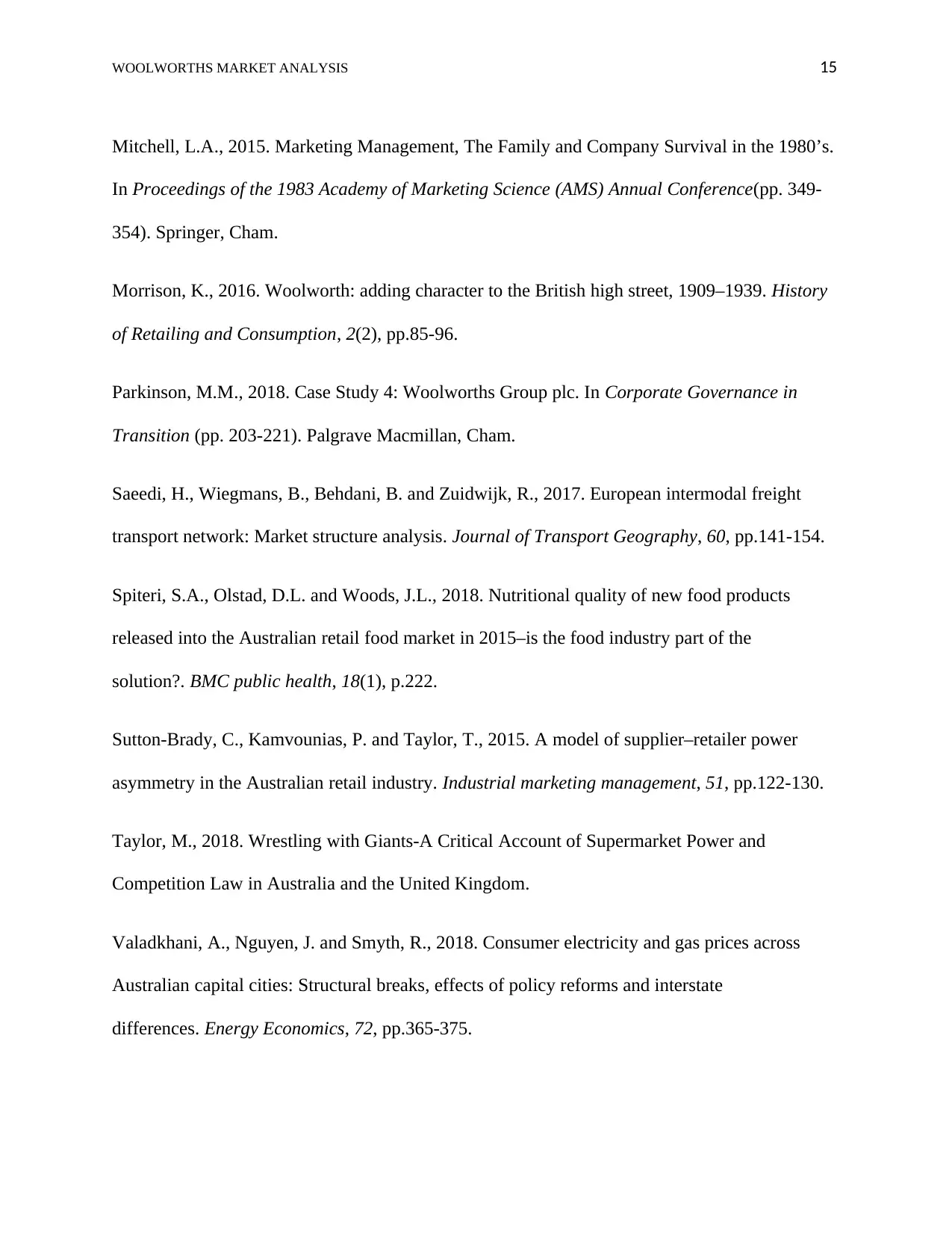
WOOLWORTHS MARKET ANALYSIS 15
Mitchell, L.A., 2015. Marketing Management, The Family and Company Survival in the 1980’s.
In Proceedings of the 1983 Academy of Marketing Science (AMS) Annual Conference(pp. 349-
354). Springer, Cham.
Morrison, K., 2016. Woolworth: adding character to the British high street, 1909–1939. History
of Retailing and Consumption, 2(2), pp.85-96.
Parkinson, M.M., 2018. Case Study 4: Woolworths Group plc. In Corporate Governance in
Transition (pp. 203-221). Palgrave Macmillan, Cham.
Saeedi, H., Wiegmans, B., Behdani, B. and Zuidwijk, R., 2017. European intermodal freight
transport network: Market structure analysis. Journal of Transport Geography, 60, pp.141-154.
Spiteri, S.A., Olstad, D.L. and Woods, J.L., 2018. Nutritional quality of new food products
released into the Australian retail food market in 2015–is the food industry part of the
solution?. BMC public health, 18(1), p.222.
Sutton-Brady, C., Kamvounias, P. and Taylor, T., 2015. A model of supplier–retailer power
asymmetry in the Australian retail industry. Industrial marketing management, 51, pp.122-130.
Taylor, M., 2018. Wrestling with Giants-A Critical Account of Supermarket Power and
Competition Law in Australia and the United Kingdom.
Valadkhani, A., Nguyen, J. and Smyth, R., 2018. Consumer electricity and gas prices across
Australian capital cities: Structural breaks, effects of policy reforms and interstate
differences. Energy Economics, 72, pp.365-375.
Mitchell, L.A., 2015. Marketing Management, The Family and Company Survival in the 1980’s.
In Proceedings of the 1983 Academy of Marketing Science (AMS) Annual Conference(pp. 349-
354). Springer, Cham.
Morrison, K., 2016. Woolworth: adding character to the British high street, 1909–1939. History
of Retailing and Consumption, 2(2), pp.85-96.
Parkinson, M.M., 2018. Case Study 4: Woolworths Group plc. In Corporate Governance in
Transition (pp. 203-221). Palgrave Macmillan, Cham.
Saeedi, H., Wiegmans, B., Behdani, B. and Zuidwijk, R., 2017. European intermodal freight
transport network: Market structure analysis. Journal of Transport Geography, 60, pp.141-154.
Spiteri, S.A., Olstad, D.L. and Woods, J.L., 2018. Nutritional quality of new food products
released into the Australian retail food market in 2015–is the food industry part of the
solution?. BMC public health, 18(1), p.222.
Sutton-Brady, C., Kamvounias, P. and Taylor, T., 2015. A model of supplier–retailer power
asymmetry in the Australian retail industry. Industrial marketing management, 51, pp.122-130.
Taylor, M., 2018. Wrestling with Giants-A Critical Account of Supermarket Power and
Competition Law in Australia and the United Kingdom.
Valadkhani, A., Nguyen, J. and Smyth, R., 2018. Consumer electricity and gas prices across
Australian capital cities: Structural breaks, effects of policy reforms and interstate
differences. Energy Economics, 72, pp.365-375.
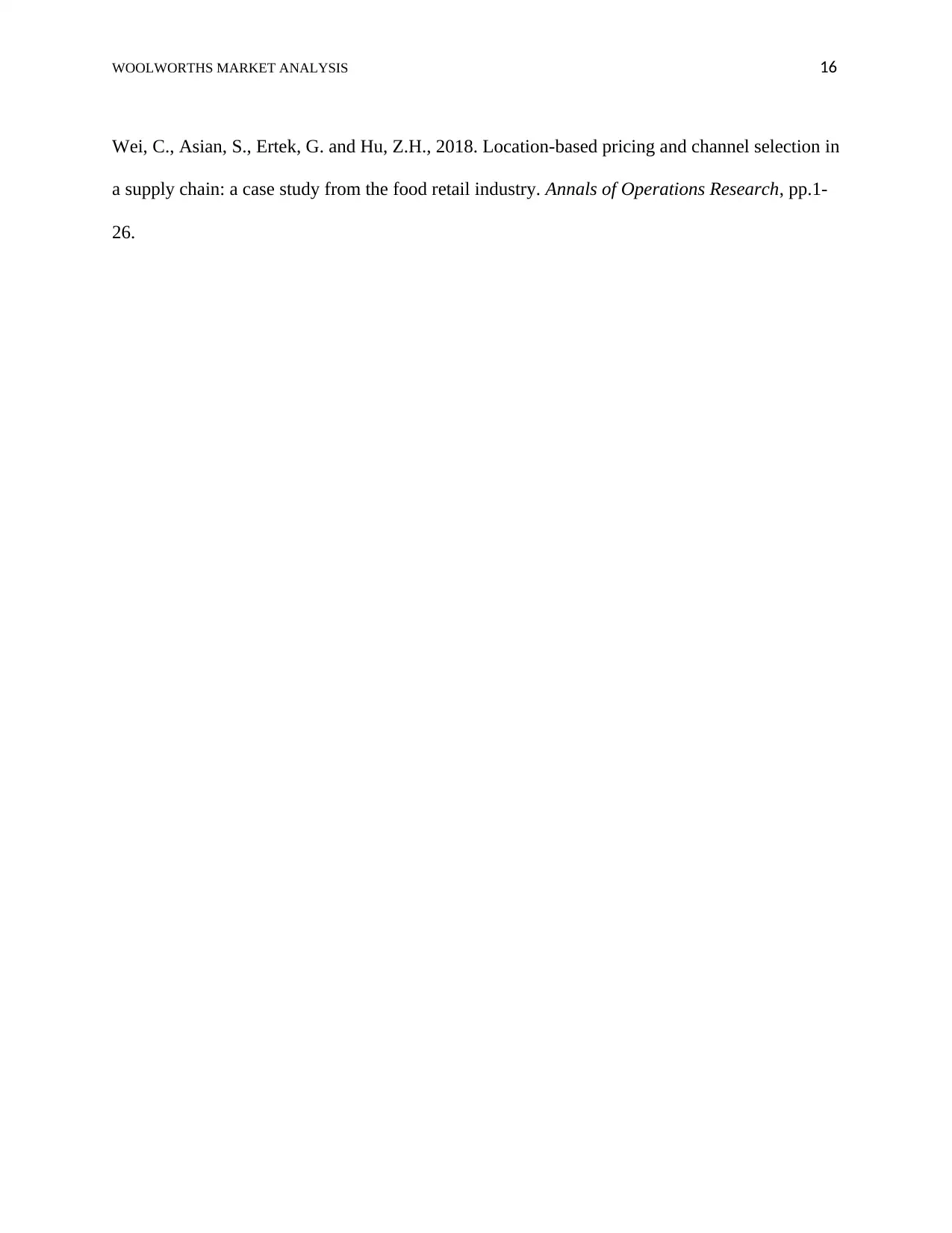
WOOLWORTHS MARKET ANALYSIS 16
Wei, C., Asian, S., Ertek, G. and Hu, Z.H., 2018. Location-based pricing and channel selection in
a supply chain: a case study from the food retail industry. Annals of Operations Research, pp.1-
26.
Wei, C., Asian, S., Ertek, G. and Hu, Z.H., 2018. Location-based pricing and channel selection in
a supply chain: a case study from the food retail industry. Annals of Operations Research, pp.1-
26.
1 out of 16
Related Documents
Your All-in-One AI-Powered Toolkit for Academic Success.
+13062052269
info@desklib.com
Available 24*7 on WhatsApp / Email
![[object Object]](/_next/static/media/star-bottom.7253800d.svg)
Unlock your academic potential
© 2024 | Zucol Services PVT LTD | All rights reserved.





